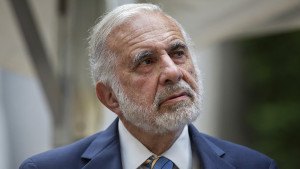


Carl Icahn, the billionaire investor known for picking fights with corporate boards, disclosed an investment in American International Group Inc. and said it should split into three companies: one offering property/casualty coverage, another selling life insurance and a third backing mortgages.
“There is no more need for procrastination,” Icahn said in a letter posted on his website Wednesday and addressed to AIG Chief Executive Officer Peter Hancock. “The time to act is now.” Icahn said on Twitter that he holds a “large stake” in AIG.
While AIG climbed about 8.8 percent this year through Tuesday’s close, the insurer still trades for less than 80 percent of book value, a measure of assets minus liabilities. Travelers Cos., the lone P/C insurer in the Dow Jones Industrial Average, trades for more than 1.4 times book value. AIG jumped 2.8 percent to $62.65 at 11:48 a.m., the most intraday since August.
Icahn, 79, said a tax-free separation into independent public companies would help AIG limit regulation. The U.S. has deemed the New York-based insurer as a systemically important financial institution, or SIFI, because of its size. The designation brings increased Federal Reserve oversight.
AIG Reorganization
“Enhanced regulation is intended to be a tax on size,” Icahn wrote in the letter. “In the face of a changing and potentially punitive regulatory framework, you must realize that insurance businesses of AIG’s caliber are more valuable to shareholders if held directly than they are as part of a SIFI conglomerate.”
Hancock, 57, who took over as CEO last year, reorganized AIG into two main divisions, with one focusing on commercial clients and the other on individual consumers. He said the arrangement responds to customer demand and makes more sense than the previous split, which had a life unit and a P/C operation. AIG also has been divesting assets to boost capital, exiting its stake in aircraft-lessor AerCap Holdings NV and selling shares of consumer-finance company Springleaf Holdings Inc.
The insurer has “taken important and significant steps to reposition AIG by both simplifying and de-risking the company,” Hancock said in a statement. “We remain on course and are determined to continue and accelerate these efforts.”
Paulson, McGee
John Paulson, the billionaire hedge fund manager who is also an AIG investor, is quoted in the letter saying that the insurer could trade for more than $100 a share if it split into three, reduced expenses, repurchased stock and matched average industry returns. Paulson in 2012 urged Liam McGee, then the CEO of Hartford Financial Services Group Inc., to separate its life insurer from the P/C operation.
McGee subsequently sold assets to simplify his company and won praise from Paulson. Travelers and life insurer Prudential Financial Inc. are among AIG rivals that sold units in prior years to narrow their focus.
‘Frankly Overdue’
“AIG is frankly overdue in following in the footsteps of all other major multilines in breaking up life and P/C,” Paulson is quoted as saying in the letter.
General Electric Co., whose finance unit is one of four non-bank SIFIs, has announced more than $120 billion of divestitures as CEO Jeffrey Immelt refocuses on industrial products spanning jet engines, oilfield equipment and locomotives. Immelt plans to apply to exit from SIFI status, a designation that could bring tougher capital, leverage and liquidity requirements.
Asked in a May earnings call if he would consider a similar strategy to escape SIFI status, Hancock said he needed more clarity on how the rules would be applied.
“Should you get off this off-ramp, there’s 200 other regulators that are also very interested in how we run the company,” Hancock said at the time. “So it’s not clear to me that getting off that off-ramp changes management’s flexibility in any material way.”
Credit Raters
AIG believes that its needs for holding capital are driven by ratings firms, not just government watchdogs, and would still be substantial if the company were split, said a person familiar with the insurer’s thinking. Intracompany guaranties would make it hard to split the businesses, and AIG would lose the advantage of cross-selling some products to corporate clients, especially outside the U.S., said the person, who asked not to be identified discussing internal deliberations.
In addition to distributing AIG’s debt among new companies, another barrier would be how to manage tax assets that the insurer accumulated because of losses in the financial crisis. Such assets can be used to lower obligations in future years.
While splitting the company would save costs, the process would be complicated, and the loss of diversity could jeopardize AIG’s credit rating, Meyer Shields, an analyst at Keefe Bruyette & Woods, said in an interview.
“The financial structure would take an awful lot of work to get through,” he said. “Management seems to think there’s a benefit to keeping them together.”
Greenberg’s Approach
AIG was built into the world’s largest insurer by former CEO Maurice “Hank” Greenberg, who added life operations and the aircraft business partly to counter the fluctuations of P/C operations. Results in those lines can swing widely based on the frequency of natural disasters or changes in prices.
The insurer’s size was seen as a hindrance in the financial crisis, after Greenberg had departed, when the company almost collapsed because of losses on mortgage-related derivatives bets and was bailed out by the U.S. in a rescue that swelled to $182.3 billion.
Hancock’s predecessor at AIG, Robert Benmosche, sold some non-U.S. life operations to help repay the bailout. Still, he resisted calls in 2011 for a breakup, saying the insurer benefits from having a variety of businesses.
Icahn has staged campaigns at companies including Hertz Global Holdings Inc., Gannett Co., Family Dollar Stores Inc. and EBay Inc. since the beginning of 2014. This month he got his way at Freeport-McMoRan Inc., the world’s largest publicly traded copper producer, which announced it was naming two of his associates to its board.